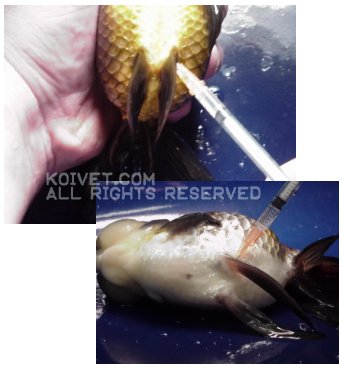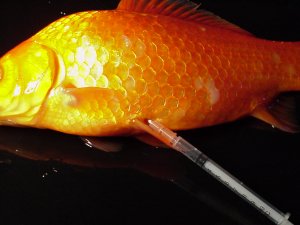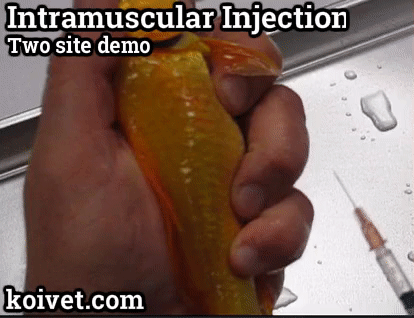Starting Off: Injection Fundamentals
Koi Fish and Injections of Antibiotics
Injections may be the only way to save the bacterially infected fish that will not eat. Soaking the infected fish in a bath of antibiotics is a last resort, but will not USUALLY save valuable fish lives.
I strenuously recommend that you obtain the necessary injectible antibiotics and the syringes and needles, and commence injections immediately. Baytril (Enrofloxacin) performs well, and is safe in various degrees of overdose. Enrofloxacin is also good because dosing can be spread out to every third day and it still works.
Nuflor (Florfenicol) is also well accepted and works, with only one injection, because it is oil based.

Injection of Koi and other ornamental fish should be undertaken only when the risks are weighed against the benefits. There is (arguably) a 5% chance that a fish will be injured or die when injected, even with a safe drug. With experience, the percentage drops dramatically. I recommend use of a 1cc tuberculin syringe. Needle size is best at 25 gauge, 3/4 inch length. Catch the fish as un-stressfully as possible. If the fish is laboring in the net, let him go and try again later. You can wrap a fish in a plastic bag with the water let out.

Insert the needle at an angle, aiming through the fish as if to emerge at the mouth, going in just behind the ventral fins, but well in front of the anus or vent. Quickly depress the plunger and withdraw the needle. You will usually pull a scale out when you inject a fish. You can put your finger at the spot the needle goes in, to hold the scale but it’s okay if a scale comes up.
DO NOT INJECT FISH IN THE BASE OF THE PECTORAL FIN.
That is a significant misunderstanding by some folks, that has then been taught to others! It is the PELVIC fins that define the injection anatomy! When you inject in the base of the pectoral fin, you may be told that this avoids liver filtration of the antibiotic. Turns out, this is NOT true and has been disproven over five years ago. Worse, injection near the pectoral fin is within a short distance from the heart and gall bladder. The pectoral fin is one of the most important fins for navigation and messing it up has a real impact. This is a VERY risky place to inject a fish.
But, I’m hardly in a position to argue the point with some super-knowledgeable elderly guys on a bitter UK Message board, as much as they know from their reading – what does my hands-on experience count for?







